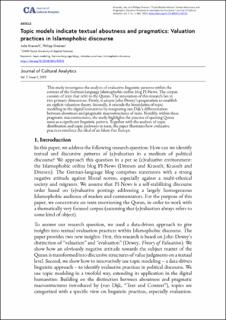Please use this identifier to cite or link to this item:
https://doi.org/10.21256/zhaw-30462Full metadata record
| DC Field | Value | Language |
|---|---|---|
| dc.contributor.author | Krasselt, Julia | - |
| dc.contributor.author | Dreesen, Philipp | - |
| dc.date.accessioned | 2024-04-12T14:55:08Z | - |
| dc.date.available | 2024-04-12T14:55:08Z | - |
| dc.date.issued | 2024 | - |
| dc.identifier.issn | 2371-4549 | de_CH |
| dc.identifier.uri | https://digitalcollection.zhaw.ch/handle/11475/30462 | - |
| dc.description.abstract | This study investigates the analysis of evaluative linguistic patterns within the context of the German-language Islamophobic online blog PI-News. The corpus consists of texts that refer to the Quran. The innovation of this research lies in two primary dimensions: Firstly, it adopts John Dewey’s pragmatism to establish an explicit valuation theory. Secondly, it extends the boundaries of topic modeling in the digital humanities by integrating van Dijk’s differentiation between aboutness and pragmatic macrostructures of texts. Notably, within these pragmatic macrostructures, the study highlights the practice of quoting Quran suras as a significant linguistic pattern. Together with the analysis of topic distribution and topic pathways in texts, the paper illustrates how evaluative practices reinforce the ideal of an Islam-free Europe. | de_CH |
| dc.language.iso | en | de_CH |
| dc.publisher | McGill University | de_CH |
| dc.relation.ispartof | Journal of Cultural Analytics | de_CH |
| dc.rights | http://creativecommons.org/licenses/by/4.0/ | de_CH |
| dc.subject | Topic modeling | de_CH |
| dc.subject | German-language blog | de_CH |
| dc.subject | Valuation practice | de_CH |
| dc.subject | Islamophobic discourse | de_CH |
| dc.subject.ddc | 401.4: Terminologie, Diskursanalyse, Pragmatik | de_CH |
| dc.title | Topic models indicate textual aboutness and pragmatics : valuation practices in Islamophobic discourse | de_CH |
| dc.type | Beitrag in wissenschaftlicher Zeitschrift | de_CH |
| dcterms.type | Text | de_CH |
| zhaw.departement | Angewandte Linguistik | de_CH |
| zhaw.organisationalunit | Institute of Language Competence (ILC) | de_CH |
| dc.identifier.doi | 10.22148/001c.92535 | de_CH |
| dc.identifier.doi | 10.21256/zhaw-30462 | - |
| zhaw.funding.eu | No | de_CH |
| zhaw.issue | 2 | de_CH |
| zhaw.originated.zhaw | Yes | de_CH |
| zhaw.publication.status | publishedVersion | de_CH |
| zhaw.volume | 7 | de_CH |
| zhaw.publication.review | Peer review (Publikation) | de_CH |
| zhaw.webfeed | Digital Discourse Lab | de_CH |
| zhaw.webfeed | Digital Linguistics | de_CH |
| zhaw.author.additional | No | de_CH |
| zhaw.display.portrait | Yes | de_CH |
| zhaw.relation.references | https://doi.org/10.7910/DVN/FRYPSL | de_CH |
| Appears in collections: | Publikationen Angewandte Linguistik | |
Files in This Item:
| File | Description | Size | Format | |
|---|---|---|---|---|
| 2024_Krasselt-Dreesen_Topic-models-indicate-textual-aboutness-and-pragmatics.pdf | 1.05 MB | Adobe PDF |  View/Open |
Show simple item record
Krasselt, J., & Dreesen, P. (2024). Topic models indicate textual aboutness and pragmatics : valuation practices in Islamophobic discourse. Journal of Cultural Analytics, 7(2). https://doi.org/10.22148/001c.92535
Krasselt, J. and Dreesen, P. (2024) ‘Topic models indicate textual aboutness and pragmatics : valuation practices in Islamophobic discourse’, Journal of Cultural Analytics, 7(2). Available at: https://doi.org/10.22148/001c.92535.
J. Krasselt and P. Dreesen, “Topic models indicate textual aboutness and pragmatics : valuation practices in Islamophobic discourse,” Journal of Cultural Analytics, vol. 7, no. 2, 2024, doi: 10.22148/001c.92535.
KRASSELT, Julia und Philipp DREESEN, 2024. Topic models indicate textual aboutness and pragmatics : valuation practices in Islamophobic discourse. Journal of Cultural Analytics. 2024. Bd. 7, Nr. 2. DOI 10.22148/001c.92535
Krasselt, Julia, and Philipp Dreesen. 2024. “Topic Models Indicate Textual Aboutness and Pragmatics : Valuation Practices in Islamophobic Discourse.” Journal of Cultural Analytics 7 (2). https://doi.org/10.22148/001c.92535.
Krasselt, Julia, and Philipp Dreesen. “Topic Models Indicate Textual Aboutness and Pragmatics : Valuation Practices in Islamophobic Discourse.” Journal of Cultural Analytics, vol. 7, no. 2, 2024, https://doi.org/10.22148/001c.92535.
Items in DSpace are protected by copyright, with all rights reserved, unless otherwise indicated.